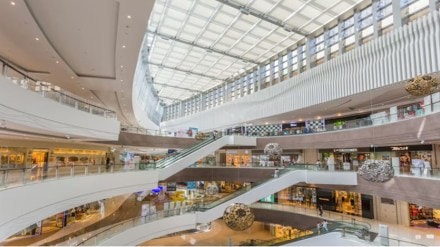By Pradeep Mishra
When it comes to the returns on real estate investments, retail properties generally offer the highest profit potential. Next in line are commercial properties, which are used for offices, followed by residential and agricultural lands. Regarding retail properties, they can be acquired either in a market or in an authorized and planned shopping complex. Nowadays, modern shopping complexes have been replaced by High Street Commercials or High Street Retail Zones. However, when discussing retail properties, it would be incomplete not to mention shopping malls.
The mall culture originated abroad in the late 1980s and early 1990s. This culture then made its way to Mumbai and by the late 1990s, Delhi got its first shopping mall on August Kranti Marg. After that, not just Delhi, but shopping malls sprang up in Gurgaon, Noida, Ghaziabad, Faridabad, and Sonepat. During the first five years of this century, those seeking retail property invested heavily in shopping malls, driven by several specific reasons, which we will explore in this article.
But just as shopping malls saw a boom in investment, many of them now lie largely vacant. Today, about 40 to 60 percent of some shopping malls are empty. Over time, such malls have earned the label ‘Ghost Malls.’ You might be wondering if the term ‘Ghost Mall’ is used simply because half of the mall is empty or if there’s something more sinister at play. Let’s explore what a Ghost Mall is, and if you’re considering buying retail property in a shopping mall, here’s what you need to be mindful of.
Also Read: Smart Festive Spending: 5 strategies to keep your wallet in check
Malls Became Popular for Shopping
Even today, retail businesses across various parts of the country operate in open markets spread along both sides of streets. But after 2002, when shopping malls began to be constructed rapidly, it seemed they would pose a major challenge to traditional markets. However, the situation today appears quite the opposite. The factors contributing to the growing popularity of malls include having cinemas, games for children, departmental stores for household items, branded showrooms for specialized shopping, and easy parking all in one place. The air-conditioned environment also played a significant role in attracting people to malls.
Given the growing interest in malls, builders even began developing such projects on small plots of land. Due to limited space, both retailers and customers experienced a lack of facilities and organization. As a result, people started avoiding certain malls altogether. The lack of footfall affected retailers’ businesses, leading them to vacate these malls and seek other locations.
Ensuring Your Mall Doesn’t Become a Ghost Mall
The second question is, what should you look for when investing in a mall to ensure that your mall doesn’t turn into a Ghost Mall? The first thing to check is the size of the mall. Understand how large a plot the shopping mall is being developed on or will be developed on. A good mall requires at least four to five lakh square feet of space for retailing, entertainment, and food courts. If the mall has at least two anchor stores, footfall will increase rapidly. Anchor stores are large retail outlets offering multi-brand shopping options.
Footfall refers to the number of people visiting the mall. If you plan to open your brand store in the mall, choose a shop in a location where it will attract the most attention. Investors often consider purchasing shops near the mall entrance, but compared to traditional markets, customers in malls usually only decide to visit a retail showroom after reaching the middle section of the mall.
Consider Revenue Sharing
Compared to traditional markets, shopping malls have additional expenses for lifts, escalators, common area maintenance, and centralized air conditioning, which also leads to higher rent for retail spaces. However, higher rent and lower footfall can result in losses for retailers. Once retailers start leaving a mall, it becomes challenging to lease out the vacant shops. If you find yourself facing such a situation or foresee such a challenge in the future, don’t hesitate to opt for a revenue-sharing model instead of rent. In this model, the tenant agrees to pay you a fixed percentage of their total or gross income, in addition to covering maintenance costs. This allows the retailer extra time to sustain their store without the burden of monthly rent.
On the other hand, you will be relieved of monthly maintenance fees and will begin earning monthly profits from your property in the near future. Currently, mall developers are also adopting this option to attract retailers and major brands. If you keep these points in mind when investing in a shopping mall property, it will surely prove to be a profitable deal for you.
(The author is CMD, ORAM Developments)
Disclaimer: Views, recommendations, opinions expressed are personal and do not reflect the official position or policy of FinancialExpress.com. Readers are advised to consult qualified financial advisors before making any investment decision. Reproducing this content without permission is prohibited.
